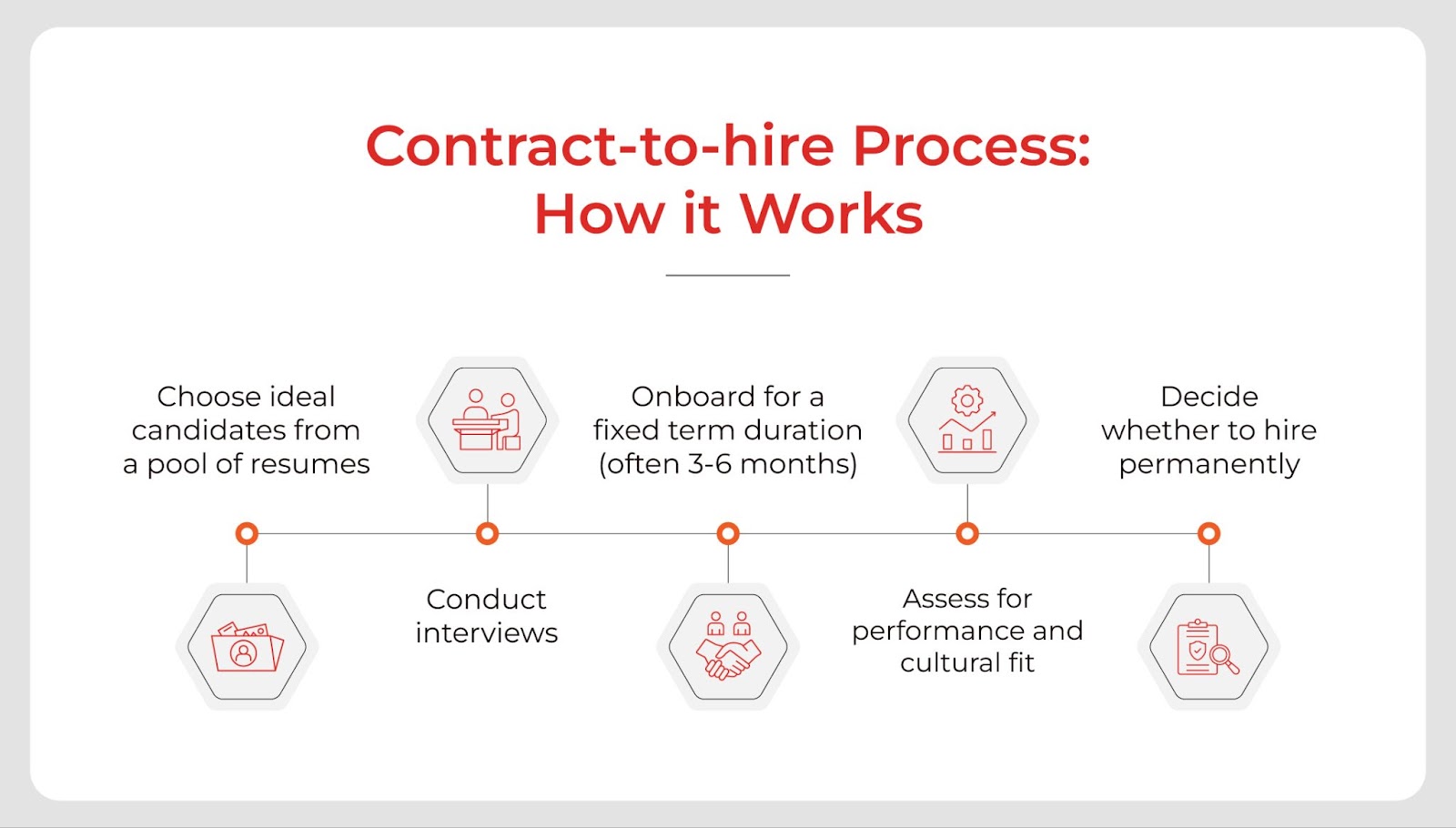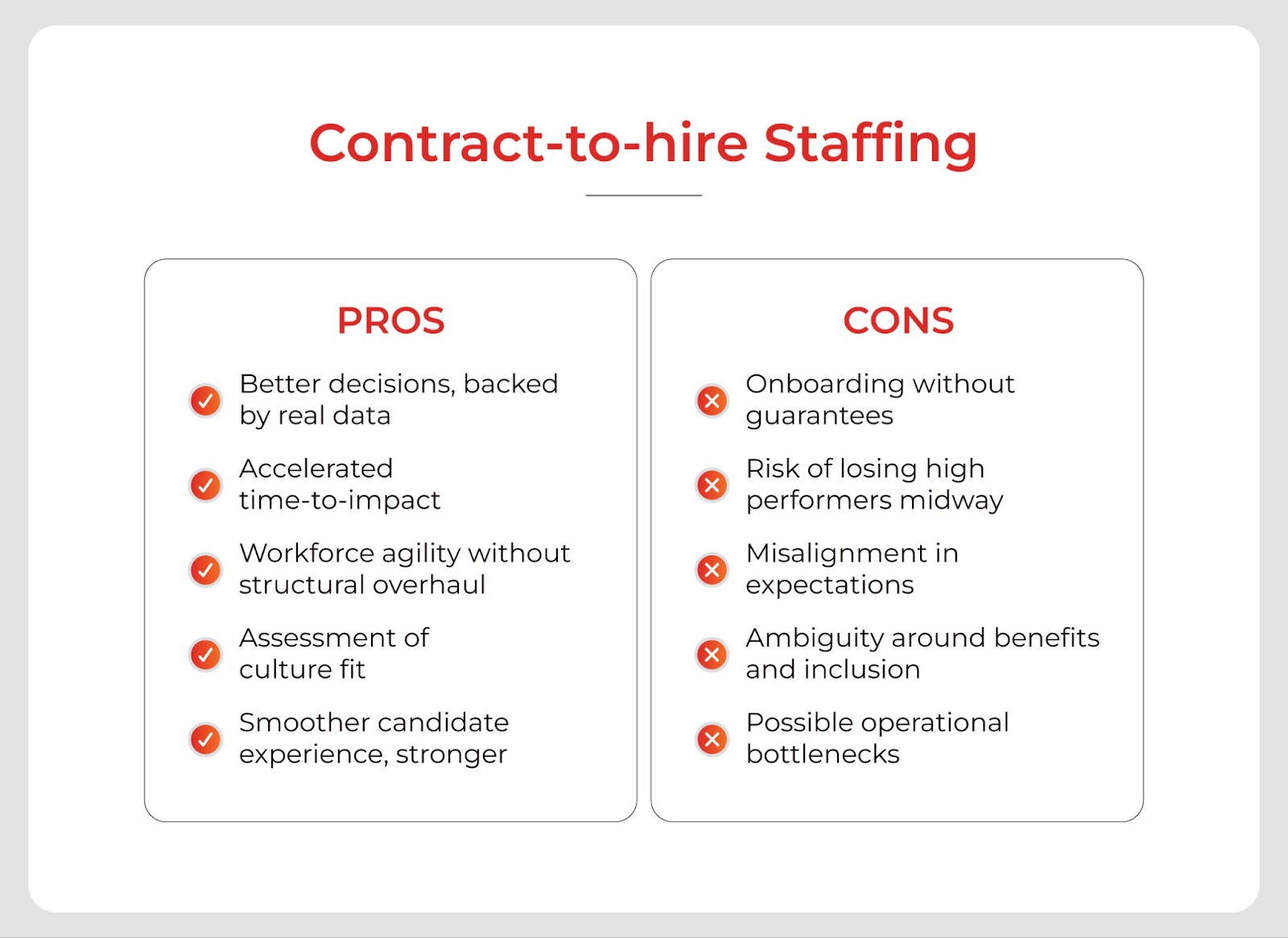When you’re under pressure to fill roles quickly without compromising on quality, even the most robust staffing strategies can come under strain.
It’s not that traditional hiring models are failing; they’ve built great teams for decades. But with project-based work on the rise, alongside evolving organizational structures and constrained budgets, one thing is for sure: employers can’t afford to hire blind.
That’s where the contract-to-hire model gains its prominence. It is a pressure-tested mechanism to hire with data, not instinct.
At first glance, the contract-to-hire meaning is straightforward: bring a candidate on board under a contract, assess them in a real work setting, and convert them to full-time if the fit is right.
But when strategically implemented, contract-to-hire does more than mitigate hiring risks.
Understanding Contract-to-Hire from a Strategic Lens
A typical contract-to-hire position begins with a fixed-term engagement, often three to six months, where the employee works on payroll through a staffing partner or as an independent contractor.
During this phase, they’re embedded in the team and perform the same duties as a full-time counterpart. Eventually, they’re assessed across tangible outcomes, soft skills, and culture alignment and, if the match works, the employee transitions to a permanent role.

Before you jump the gun and call it a method employers use to delay commitment, hold on!
They are using the contract-to-hire model to test fit in a controlled, high-stakes environment, where performance speaks louder than interviews ever could.
Think about roles that demand both technical competence and contextual agility. Think about roles that demand both technical competence and contextual agility, like a product manager driving a cross-functional launch or a data analyst navigating fast-moving projects. With contract-to-hire, you get to see this person in action, solving problems, adapting quickly, and working with your team in real conditions, not just interview scenarios. This is often the only reliable way to separate great candidates from the good ones.
But more than capability, fit is also about timing. In many cases, contract-to-hire allows leaders to onboard someone immediately for a project or priority initiative, without getting bogged down in the long process of securing full-time headcount. That speed buys flexibility. And that flexibility makes it easier to adapt and make smart hiring choices, especially in dynamic hiring cycles where the requirements evolve faster than traditional hiring methods and paperwork can keep up.
Let’s be clear: to define contract-to-hire solely by its timeline misses the point. The value of the model lies in how it aligns hiring with real-time business requirements, not just job descriptions.
Used right, it’s a great talent filter with performance as the screening mechanism.
The Upside: Pros of Contract-to-Hire Staffing for Employers

Contract-to-hire staffing model adds an evaluative layer to hiring without slowing it down. When implemented with intent, it can streamline decision-making, strengthen team performance, and reduce costly hiring errors. With contract-to-hire, you have:
1. Better decisions, backed by real data
The most compelling reason for employers to turn to contract-to-hire is that it eliminates guesswork.
Resumes and interviews offer limited signals. But when a candidate is embedded in the team for 90 to 180 days, performance becomes observable and measurable. You get data on how they work, solve problems, respond to feedback, and contribute to outcomes.
Think of it as a trial period that generates valuable insights.
2. Accelerated time-to-impact
Contract-to-hire is fast. Faster than traditional hiring cycles that require layers of internal alignment, approvals, and onboarding lead time.
Because candidates are typically sourced and deployed by staffing partners, ramp-up begins quickly. Employers can fill skill gaps immediately, whether for backfilling, pilot initiatives, or scaling demand. This shortens the time between need and delivery, which is often where traditional models struggle.
3. Workforce agility without structural overhaul
Headcount is often a lagging indicator of business need. Contract-to-hire lets you bypass that lag.
You can respond to immediate operational requirements without prematurely altering long-term workforce structure. If the need sustains, the candidate transitions. If not, there’s no obligation to convert.
This model is particularly effective for:
- Pre-hiring in anticipation of funding rounds
- Expanding into new verticals or functions
- Scaling after acquisitions or reorganizations
4. Assessment of culture fit
Culture fit isn’t something you can fully gauge from a resume or a 30-minute interview. Contract-to-hire lets you see how someone actually gels with your team, whether it’s jumping into brainstorming sessions, grabbing coffee with colleagues, or joining the lunch banter. This model allows you to see the real person behind the resume, before you make it official.
But why not assess during the interview? Because it’s one thing to assess the fit in theory and another to observe it in practice.
5. Smoother candidate experience, stronger employer brand
This often gets overlooked, but the contract-to-hire position can enhance your employer brand if you keep them informed about your intentions from the start. Candidates appreciate clarity. When they know there’s a clear path to conversion —and when that path is tied to real outcomes —it builds trust.
It tells candidates: We hire with intent, not assumptions.
The Flip Side: Cons of Contract-to-Hire Staffing That Employers Must Watch Out For
Contract-to-hire is definitely not a plug-and-play model. And while the benefits are real, so are the challenges. Understanding them upfront helps employers avoid poor outcomes and maximize long-term ROI.
1. Onboarding without guarantees
Here’s the first bone of contention: you’re still onboarding, training, and integrating someone who might not stay. That requires time, effort, and internal resources, especially if the role is technical, customer-facing, or cross-functional.
If you treat contract-to-hire like a short-term, hands-off engagement, you’ll miss the real signals you need to assess performance. But if you go all-in by onboarding them fully and integrating them deeply into your team, you’re committing real resources without the certainty of a long-term payoff. In other words, you’re making an upfront investment without a guaranteed return.
So, what’s the right way to approach it?
Treat contract-to-hire employees like long-term investments, but only in environments where performance signals can be observed quickly and directly.
2. Risk of losing high performers midway
A strong contractor is often a high-demand profile. If your contract period drags or lacks clarity, you risk losing that person to a competitor offering immediate conversion or better terms.
Remember, contract-to-hire is a two-way evaluation. If you’re not communicating intent or moving fast enough on conversion decisions, top talent may walk off.
What’s a winning strategy?
Signal seriousness early. Set review checkpoints and ensure your internal hiring team is aligned on conversion triggers.
3. Misalignment of expectations
Contract-to-hire is not failsafe. Even with a clear contract, mismatched expectations can happen.
The contractor might treat the engagement as a stopgap, not a serious opportunity. The manager might delay feedback or defer decisions, under the impression that the role isn’t “official” yet. This dynamic can cause friction in teams, create inconsistent performance feedback, or worse, turn off the candidate before you get to conversion.
The key here is to manage contract-to-hire roles with the same structure, feedback loops, and accountability frameworks as permanent roles.
4. Ambiguity around benefits and inclusion
This is one of the most frequently cited concerns in TA teams. Are contract-to-hire employees eligible for bonuses, paid leave, or professional development budgets? Are they invited to team offsites? Do they get manager-level 1:1s?
These gray zones create inconsistencies that affect morale, both for the contractor and for the full-time employees working with them.
Define and document your inclusion policy for contract-to-hire positions:what applies, and what doesn’t? Communicate this upfront and not reactively.
5. Possible operational bottlenecks
Conversion isn’t always a cakewalk. If your systems aren’t prepared to transition an employee mid-year, from payroll to benefits to HRIS updates, you’ll face friction. Worse, the candidate may feel like their engagement is an afterthought during conversion, and this may affect their long-term engagement.
How do we solve for this?
Build a conversion SOP. From approvals to documentation and onboarding, make sure the back-end process is clean and clear to all parties involved.
The Bottom Line
When used deliberately, contract-to-hire can be a powerful lever, connecting the right talent with the right opportunities at the right moment. It offers a low-risk way to assess employee-fit, and make data-backed hiring decisions. But its value is not automatic. It demands careful planning and purposeful implementation.
If you are ready to evolve your approach to staffing, treating hiring as a flexible and agile process for long-term benefits, contract-to-hire may be the competitive edge you’re looking for.
Explore how SPECTRAFORCE can help you build a smarter, faster, and more agile workforce with our tailored contract-to-hire solutions.
Frequently Asked Questions (FAQs)
A contract-to-hire position is a role designed for conditional permanence. A candidate is brought on for a fixed-term contract, usually through a staffing partner. The intent is to convert them to a full-time employee based on performance, fit, and business need. It can be seen as a live evaluation period that directly feeds into long-term hiring decisions.
The contract-to-hire staffing process is simple on paper, nuanced in execution. The candidate joins as a contractor, integrates into your team, and is assessed over a defined period. If the match works, they’re converted to FTE. Internally, this demands alignment between TA, HR, and the hiring manager, especially on conversion criteria and timelines.
The industry standard ranges from 3 to 6 months. Some firms use 90 days as a performance checkpoint; others stretch to 180, especially in more complex or technical roles. What matters more than duration is clarity on milestones, feedback loops, and when conversion decisions will be made.
Not typically. During the contract phase, benefits are usually provided (if at all) by the staffing partner, not the employer. That said, employers should clearly communicate what changes(if any) will occur at the point of conversion to full-time.
The contract-to-hire staffing process typically involves these steps:
1. Identify the need and define contract terms
2. Source candidates (often through a staffing firm)
3. Conduct interviews with conversion potential in mind
4. Onboard as a contractor
5. Monitor performance and team alignment
6. Decide on conversion at or before the contract ends



